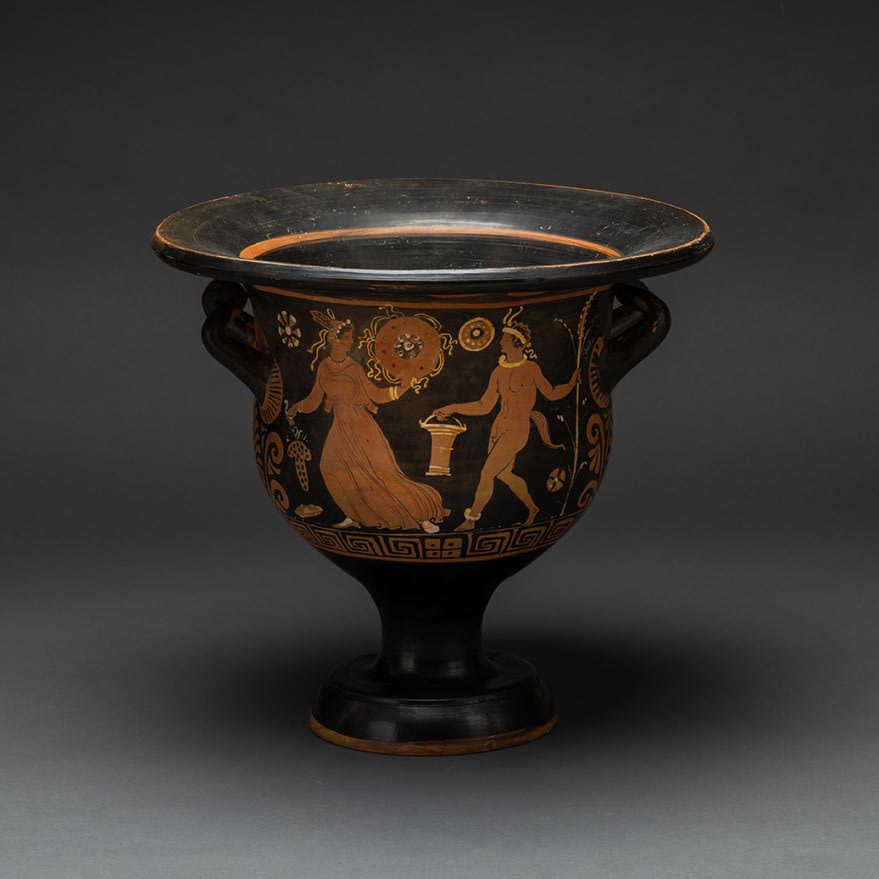Apulian Red-Bell Krater, 400 BCE - 300 BCE
Terracotta
35 x 39 cm
13 3/4 x 15 3/8 in
13 3/4 x 15 3/8 in
SF.046
An essential vessel for anyone wishing to partake in the Bacchic pastime of wine-drinking, this wide-mouthed bell krater was specifically designed for holding large quantities of liquid; as it was...
An essential vessel for anyone wishing to partake in the Bacchic pastime of wine-drinking, this wide-mouthed bell krater was specifically designed for holding large quantities of liquid; as it was considered barbaric for wine to be drunk neat (and a privilege only enjoyed by Bacchus/Dionysus and his entourage who could handle such a level of intoxication) wine would be mixed with water, usually 1 part to 3. As such, craters provided an ideal large surface area for decoration, and as wine was of utmost importance to the Symposium, kraters would usually take centre place, and as such, the decoration of such vessels were geared towards such gatherings and attempted to provide subject matter for philosophical debate, or more usually, for titillation.
The obverse of this krater his highly jovial. To the left is a woman, her finely pleated dress swept behind her as she dances while also looking round behind her to her fellow reveller. Added yellow paint details her jewellery, bracelets and necklaces, and in her left hand she holds a large decorated cymbal to play along with the undoubtedly cacophonous Bacchic procession that is taking place. Her fellow celebrant is a Bacchic Satyr, indicating that this is a mythical scene. He is nude, but is decorated with a garland around an ankle, as well as one around his neck and head, above which protrude his horns. He carries a Thyrsus on one hand, and in the other a bucket, possibly full of wine or incense. Decorative rossettes take up the extra space in the background. Both figures are finely drawn, the skill of the artist showcased in his ability to depict movement and the body’s reaction to it. The added yellow for detail adds another dimension to the scene, and is typical of 4th Century B.C. vase painting. On the reverse, as is typical with drinking vessels, is a more sombre scene, the intention being to provide a conversational dichotomy. Two men stand facing each other, both wrapped in a travellers cloak and holding a walking stick. Between them is half a palmette, possibly to indicate a tombstone.. It could be that both figures travelled to visit the tomb of a loved one, or it could be that both are travelling on their way to death. It would be these kind of discussions that the decoration of this vase would have brought. A fine Greek key motif provides the platform for all these figures to stand upon, and decorative palmettes separate the two scenes, being placed under each handle. As is usual for these vessels, a band of vine leaves run around the top.
The obverse of this krater his highly jovial. To the left is a woman, her finely pleated dress swept behind her as she dances while also looking round behind her to her fellow reveller. Added yellow paint details her jewellery, bracelets and necklaces, and in her left hand she holds a large decorated cymbal to play along with the undoubtedly cacophonous Bacchic procession that is taking place. Her fellow celebrant is a Bacchic Satyr, indicating that this is a mythical scene. He is nude, but is decorated with a garland around an ankle, as well as one around his neck and head, above which protrude his horns. He carries a Thyrsus on one hand, and in the other a bucket, possibly full of wine or incense. Decorative rossettes take up the extra space in the background. Both figures are finely drawn, the skill of the artist showcased in his ability to depict movement and the body’s reaction to it. The added yellow for detail adds another dimension to the scene, and is typical of 4th Century B.C. vase painting. On the reverse, as is typical with drinking vessels, is a more sombre scene, the intention being to provide a conversational dichotomy. Two men stand facing each other, both wrapped in a travellers cloak and holding a walking stick. Between them is half a palmette, possibly to indicate a tombstone.. It could be that both figures travelled to visit the tomb of a loved one, or it could be that both are travelling on their way to death. It would be these kind of discussions that the decoration of this vase would have brought. A fine Greek key motif provides the platform for all these figures to stand upon, and decorative palmettes separate the two scenes, being placed under each handle. As is usual for these vessels, a band of vine leaves run around the top.
